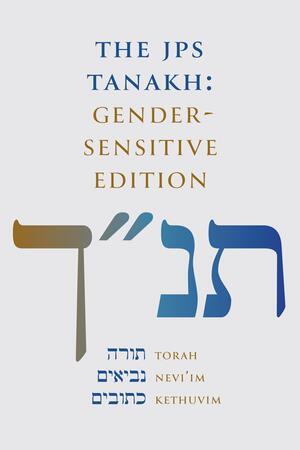What's a "Gender-Sensitive" Bible Translation?
“What’s a ‘gender-sensitive’ Bible translation?”
“Did The Jewish Publication Society just publish a ‘woke’ Bible?”
“Are you changing the Bible’s Hebrew?”
As a member of the translation team and the publisher, respectively, we’ve been receiving these sorts of questions ever since The Jewish Publication Society (JPS) released THE JPS TANAKH: Gender-Sensitive Edition in October 2023. The first major update of the iconic 1985 JPS translation of the Tanakh (Hebrew Bible), this new edition reflects advances in scholarship and changes in English while maintaining utmost fidelity to the Bible’s original Hebrew. This edition also represents a groundbreaking partnership between JPS and Sefaria, appearing simultaneously in print and online.
At the same time, this edition has also generated questions, confusion, and even some controversy—about what it’s trying to accomplish, about how it treats the Bible’s Hebrew, and about what it means for the experience of encountering the Tanakh’s ancient words today.
Most importantly, this new translation is precisely that: a new translation. It doesn’t touch the Bible’s Hebrew; instead, it asks how that Hebrew should be translated in a way that’s both historically rigorous and religiously meaningful. In particular, this new edition is gender-sensitive in the sense of being attentive to how gender and language function in the Bible. It goes through the Tanakh word by word, line by line, verse by verse, and asks when gender-inclusive renderings are appropriate and when gendered ones are called for historically and linguistically. For example, it asks whether a given term for a human being should be translated as “person” or as “man.” Similarly, it asks whether a specific reference to God should be translated with gender-neutral language (for instance, simply as “God”) or with a male-sounding term (such as “King”).
A prime example is the creation of human beings. In the 1985 JPS translation, this narrative appeared as follows:
And God said, “Let us make man in our image, after our likeness. They shall rule the fish of the sea, the birds of the sky, the cattle, the whole earth, and all the creeping things that creep on earth.” And God created man in His image, in the image of God He created him; male and female He created them. (Genesis 1:26-27)
Still a favorite for many today, this 1985 translation was a tremendous achievement in terms of its presentation of the Bible in what was then contemporary English, as well as the way it applied academic scholarship and centuries of Jewish commentary to its interpretive choices. However, forty years have passed since then, and those decades have brought significant changes not only in English, but also in a wide range of academic fields. Generations of scholars, many of them women, have advanced and at times transformed our knowledge of the ancient world. These developments have revealed a number of potential problems with the rendering offered above.
First, the 1985 translation assumes that the biblical God can be described in English with masculine terms—as a “He” who created humanity in “His” image.
Of course, it’s true that the Bible uses masculine grammatical forms in Hebrew when talking about God. Nevertheless, it’s far from clear that this requires male language in English. When the 1985 JPS translation appeared, it was still common for English speakers to use male language in a generic manner—to use “man” or “mankind” to mean “humankind,” including both men and women, or to use “man” or “he” to mean anyone, regardless of gender. In 1985, then, hearing “He” and “His” for God might have sounded neutral and natural.
Today, however, that’s simply not how English works in many settings. Often, we try to avoid saying “man” or “mankind” when we mean “humanity.” Often, we try to avoid saying “man” or “he” when we’re not specifically referring to a person who identifies as male. Masculine language like “he,” “his,” or “man” can now sound jarring, like an intentional attempt to emphasize the maleness of whomever we’re discussing.
As Rabbi Lieberman wrote for JWA, the result is that describing God as “He,” and as creating humanity in “His”image, now sounds very different than it did in 1985. Rather than sounding natural and neutral, it can come across as deliberate and disconcerting. It can sound like the Bible is casting God as male, or at least like the Bible is deliberately associating God with maleness.
This is a problem. First, it’s not clear that the Bible is actually attempting to convey the idea that God is male. While some Bible scholars argue that the Tanakh’s audience in the ancient world would have understood God as male, others reject this idea and suggest that the Tanakh’s ancient audience would have understood God as beyond gender. In other words, using English terms like “His” and “He” might actually distort or conceal the meaning of the Bible’s Hebrew.
For many readers in 2024, male English terms aren’t just historically inaccurate; they’re also religiously alienating. Some readers experience God as beyond gender. Some experience God as encompassing multiple genders. Some simply aren’t sure and want to come to their own conclusions.
For these readers, when a translation uses terms like “He” or “His” for God, it can seem like the Tanakh simply isn’t for them. It can seem like the translation is unnecessarily pre-judging the question of God’s gender. It can seem like the translation is imposing a male image of God even when that’s not how they understand the Deity—and even when that male image isn’t required by the Bible’s text, context, or anything else. As a result, this sort of male-focused translation risks setting up barriers between readers and communities on the one hand, and the Hebrew Bible and its teachings on the other.
The same is true of using the term “man” to describe the people created in God’s image. It can feel like the translation is emphasizing the maleness of the human beings who reflect God’s image, even though those human beings are explicitly described as “male and female.”
All of these issues motivated our new translation, which is often referred to as RJPS, or the Revised JPS edition. We decided that fidelity to the Bible’s Hebrew, its ancient content, and contemporary life required an updated translation, one that scrutinized every word, every line, and every verse to determine what type of English was called for in each case.
So look at Genesis 1:26-1:27 in the new translation (with changes highlighted in bold):
And God said, “Let us make humankind in our image, after our likeness. They shall rule the fish of the sea, the birds of the sky, the cattle, the whole earth, and all the creeping things that creep on earth.” And God created humankind in the divine image, creating it in the image of God—creating them male and female.
References to the creation of “man” have become references to the creation of “humankind,” reflecting our determination that what’s recounted here is the creation of all humanity in God’s image—and not a claim about the maleness of the human beings who reflect that image. Similarly, terms like “He” or “Him” are no longer used to refer to God, reflecting our commitment to no longer imposing a male image of the divine on readers.
In this way, the new translation seeks to open up the biblical text. Rather than setting up barriers, we’re providing access to the Bible’s richness and complexity. Rather than pre-judging whether the biblical God can be described as male, we’re making it possible for that Deity to be understood and encountered in diverse ways. We’re empowering readers to make their own interpretive decisions, to have their own religious experiences, and to view the Bible with fresh eyes.
The work of Bible translation is never done. Our hope is that THE JPS TANAKH: Gender-Sensitive Edition marks a new chapter in this ongoing story, providing readers and communities with renewed access to the Bible’s ancient world and timeless lessons.
You can learn more and order your copy of THE JPS TANAKH: Gender-Sensitive Edition here.









The Hebrew Bible was written in a time in which the culture was a male dominated society and, as such, the social norms of the time defined what roles women played in society, how they worshiped, marriage expectations, and commerce to name a only a few. These norms still exist in some cultures today and have changed radically in others. What concerns me is this seems to be a capitulation to cultural relativism which demands the Bible change to reflect a more enlighten times in which we live rather than respect the cultural context in which the original Hebrew Bible was written and lived out. I am more interested in reading a translation that respects the cultural norms in the society in which it was written and how those norms influence the authors original intent when he wrote the text rather than, make assumptions about the author intent through the lens of our changing society.